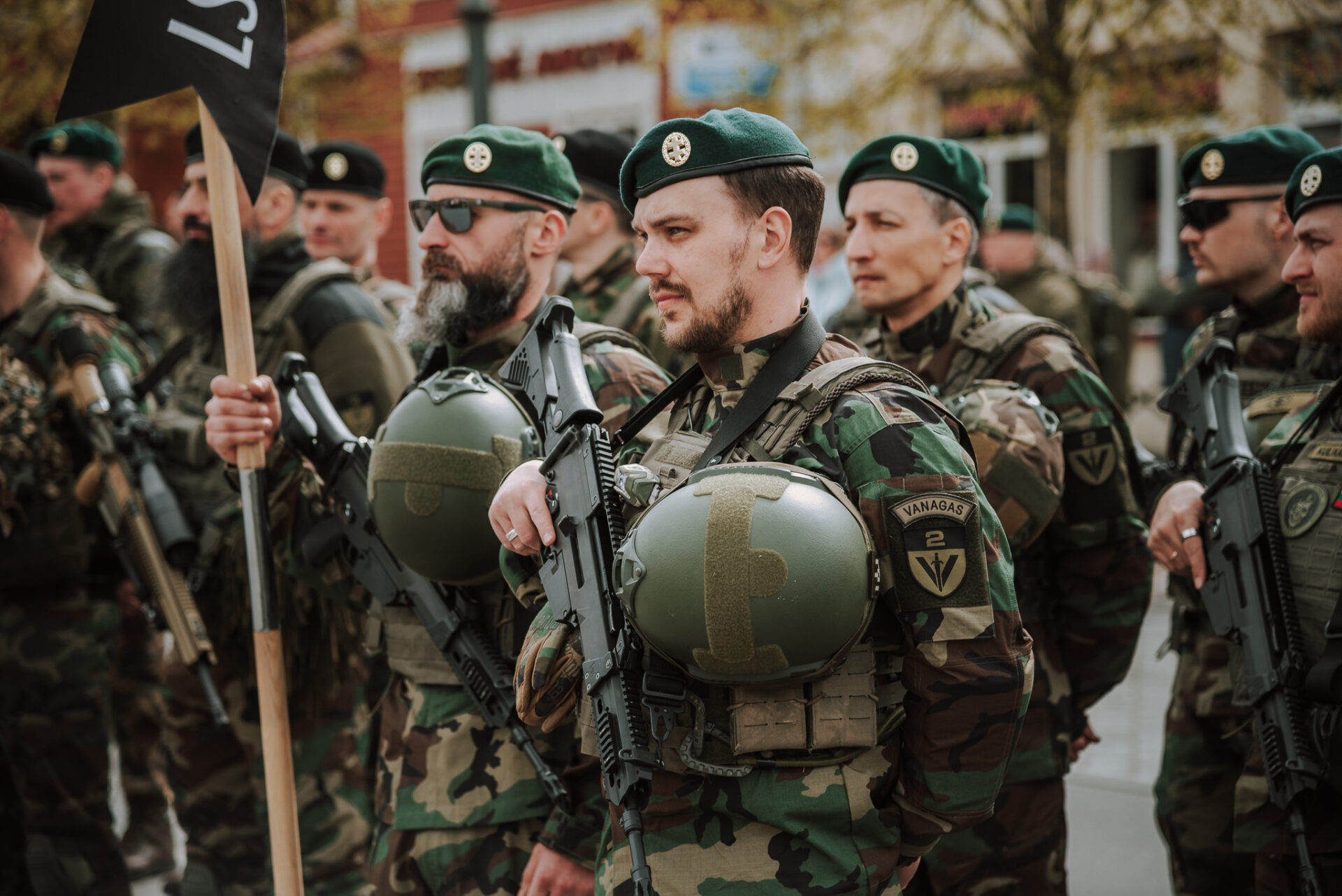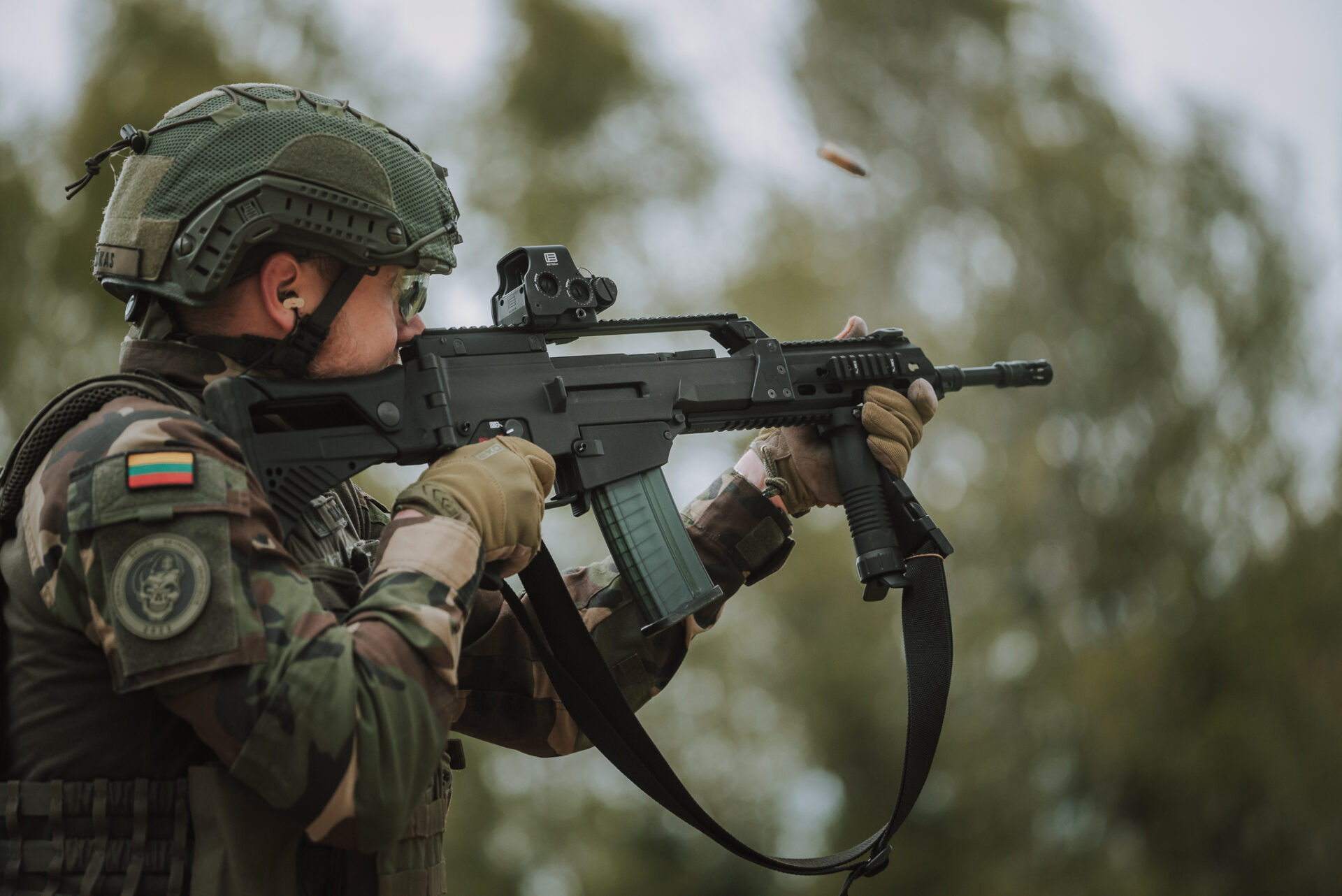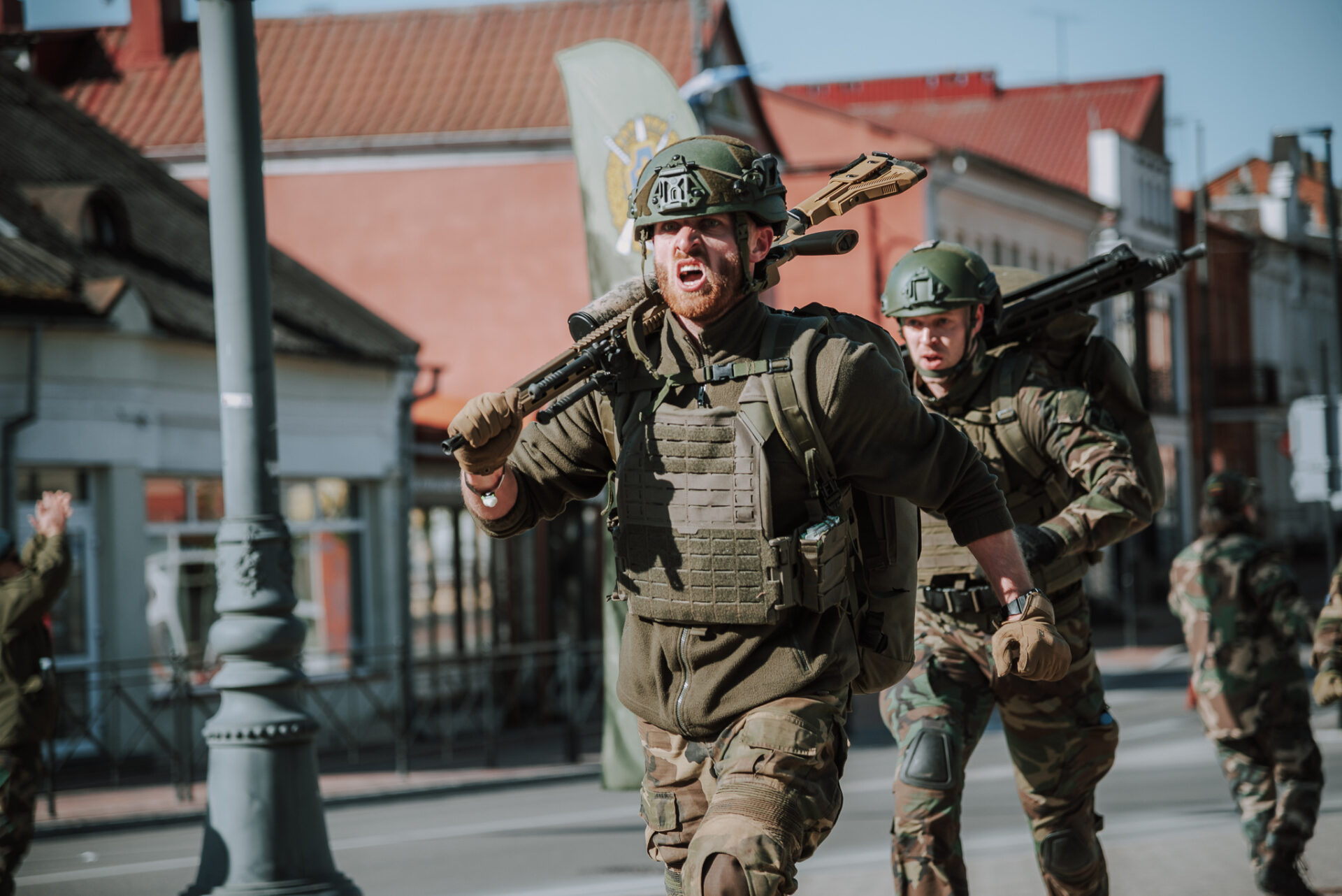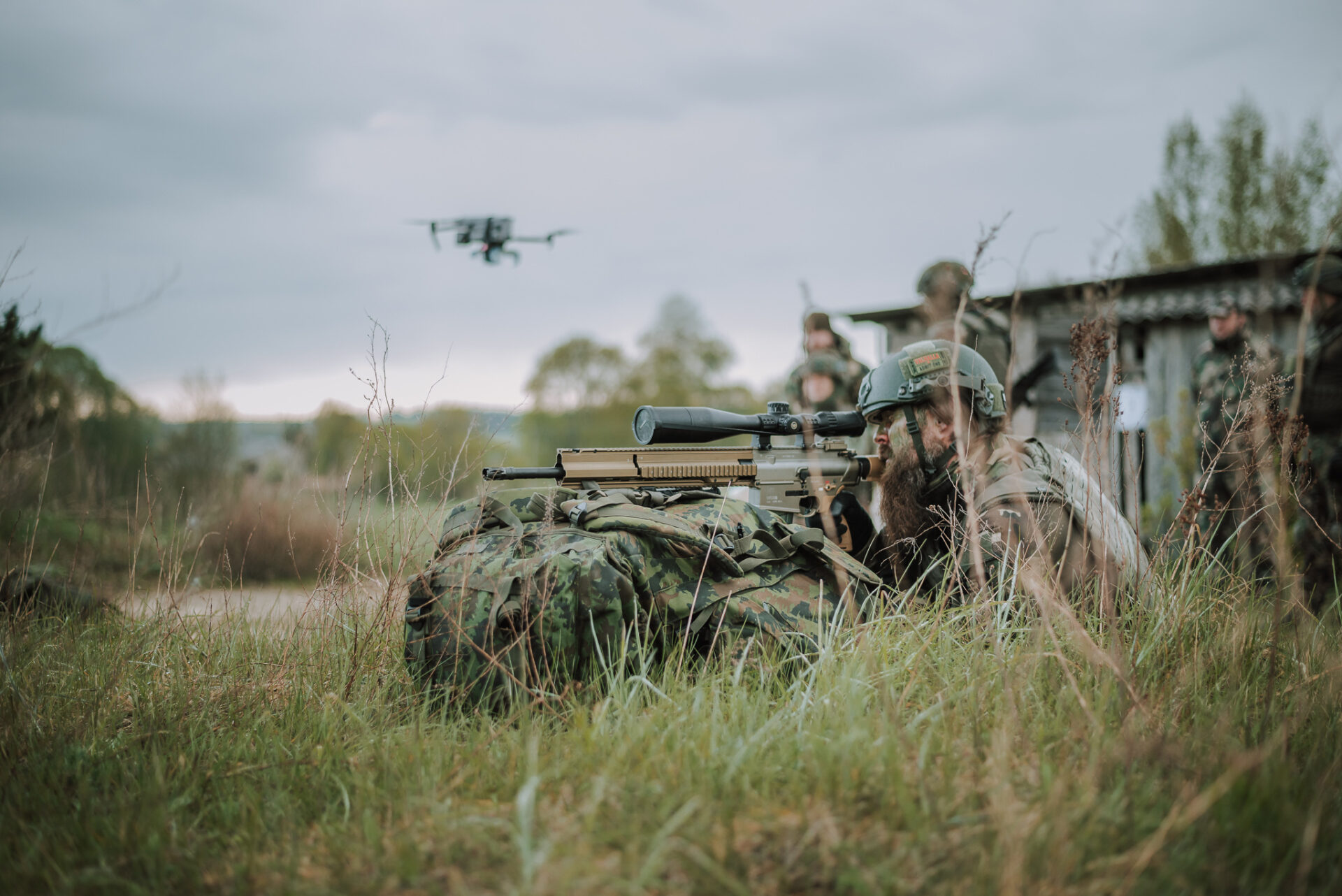Crouched low on the ground, three Lithuanian militiamen were studying a map and debating where to direct a drone. Around them, men in dark camouflage fatigues lay prone with their rifles aimed outwards. From the pine trees clustered around them to the unmanned aerial vehicle buzzing overhead, the scene felt reminiscent of Ukraine’s eastern battlefields.
When the drone reached its target, however, it dropped not a bomb but a bottle of water. The men were not soldiers but civilians, part of a national effort to prepare for a Russian invasion they hope will never come.
As America attempts to enforce a ceasefire and eventual peace in Ukraine, leaders in the Baltics are worried about where Vladimir Putin’s battle-hardened forces might turn next. When the Russian army has no war left to fight to their south and no grinding battles slowing down the rate at which their manpower can be replenished, these small nations, so they warn, will become Europe’s new frontline.
Lithuania — nestled snugly between Kaliningrad, a Russian outpost, and Belarus, a vassal — is preparing rapidly to defend against its eastern neighbour. Last month, Vilnius authorities published wartime evacuation plans. The government is building “dragon’s teeth” anti-tank fortifications along its borders. Speaking last year, then defence minister Laurynas Kasčiūnas said he hoped his country might become a “Lithuanian hedgehog” that could deter the “much stronger Russian bear”.
Increasingly central to these efforts is the Lithuanian Riflemen’s Union, a state-backed paramilitary that has seen its numbers double to 17,000 since 2022. Around 11,000 members are adults, with the remainder composed of teenagers who go hiking, help the elderly and study warfare in preparation for future service in either the armed forces or the militia. Lithuania, with a population of just under three million, does not have a professional army capable of effective defence on its own. So, as they did in the Forties against the Soviets, its civilians are preparing to fight.

In the event of a war, the Riflemen will be called on to secure the nation’s critical infrastructure and defend its interior while the military battles Russian troops. If Lithuania is occupied, they will remain as stay-behind forces and conduct armed resistance.
Over several bright spring days earlier this month, teams of Riflemen gathered from across the country in Telšiai, a picturesque town that slopes down to the shores of a lake. There they competed against each other in a series of tasks designed to prove their readiness for combat: shooting drills, crossing a fake minefield, and crawling through rotting animal carcasses to simulate the sensory horrors of war.
Small groups of young men and a few women could be spotted taking a break — with painted faces, listening to heavy metal on portable speakers, cigarettes between their teeth.
Watching an inexperienced team as they attempted to steer a first-person view (FPV) drone, 41-year-old Andrius struggled to contain his disappointment. “These drones are not hard to fly,” he said. “There are clips on YouTube where a chimpanzee flies one.” Spending most of his time administering Linux servers in Vilnius, he had the distinct look of a man more comfortable in an office than on the battlefield.
Long a hobbyist who lived for drone racing “from dusk till dawn”, Andrius first realised the military significance of his passion when he saw FPV footage from Ukraine in late 2022. “I remember only Ukrainian shouting like, ‘that target is behind the blue door’,” he said. “They were looking from the drone and flying trying to catch the enemy around the building.” Now, he said, nobody can hide.
As a part-time volunteer force, the Union’s great advantage is that it can draw from the expertise of professionals across Lithuanian society. Members have been called on to teach the army how to hide from, deploy and fight drones. Other Riflemen are using their expertise in tactical combat casualty care to help hospitals practise wartime treatment. “When I joined the Riflemen it was an organisation for children and pensioners,” one 20-year veteran told me. “Now we are a real military force.”
Since he signed up with the militia following the invasion of Ukraine, Andrius has travelled to Kyiv to learn how his counterparts are holding the line against the odds. In 2022, civilian volunteers proved essential to defending the Ukrainian capital from advancing columns of Russian tanks. Lithuanian military planners believe the same will likely prove the case for them.
Overseeing the Telšiai exercise was Lieutenant Colonel Linas Idzelis, a former military officer elected to lead the Riflemen in 2023. When we met in a field outside the city, he told me he had been reading The Home Guard Companion, a training manual given to British civilians during the Second World War.

Discussing Russia he began to fizz with anger. They are Asian, not European, he insisted: the Mongol Yoke turned them into savages; in the 17th century they cut one third of Lithuanians into pieces. “If they go into Europe,” he argued, “there will be no civilians anymore.” For Idzelis, there is no debate as to whether Russia will attack the Baltics. “If you read all the assessments which are provided now by the intelligence organisations, this is just a matter of time,” he said.
When the Soviet Union began to fall apart at the end of the Eighties, Idzelis was a long-haired teenage metalhead attending school in Vilnius. Once protests began against Moscow’s rule, he attended with his parents, brandishing a Lithuanian flag and helping to construct barricades.
In 1990, the country became the first member state of the Soviet Union to declare its independence. Gorbachev responded by declaring an economic blockade and then, when Vilnius refused to back down, sending forces from the army and the KGB to launch a coup. When civilians rushed to the capital to defend their newfound independence, 14 were killed as soldiers began firing on the crowd.
“When one of the buildings was assaulted, I was standing like five metres away from the colonel who was shooting into our guys who had defended the building,” Idzelis remembered. Ignas Šimulionis and Darius Gerbutavičius, two fellow heavy metal fans who had studied with him before joining the Riflemen, were killed.
Over 30 years later, the lieutenant colonel is clear about the threat facing his country. “The understanding is that for us no one really wants to go to Siberia,” he said. “It’s better to die in a trench than to chop trees somewhere in Siberia.”
The torture of Ukrainian civilians by Russian soldiers was not a shock to Lithuanians, he said. “Maybe for you this is, ‘Oh, fuck, shit’. But we experienced it many times. We know what we can expect. In the United Kingdom you cannot expect such kinds of things.”
Europe will never reach a war footing until its citizens witness Russia attacking a Nato power, Idzelis believes. The continent’s latent military industrial capacity has handicapped his preparations for combat. “In the Western world, I think in the future we’ll be lacking manpower,” he said. “Here, we have manpower but no equipment.”

The Riflemen’s Union has paid a Swedish defence firm for a shipment of grenade launchers but will not see them for another three years. An order of tanks will not be ready for between five and eight. In response, the militia is building its own FPV drones, ready to follow the Ukrainian lead and inflict mass casualties at little cost.
Until relatively recently, Nato military planners believed there was little chance that the Baltics could hold off a Russian invasion. They also feared that expanding into eastern Europe might antagonise Putin. In 2017, however, their mindset shifted in response to the invasion of Crimea and battle groups were sent east.
The numbers involved have been largely symbolic, however. These forces were intended to act as tripwires rather than to fight a real war. Under a defence-in-depth model, the alliance expected to throw reinforcements forward following an attack and only retake territory from Russia after it had been occupied. Since 2022, with the horrors of Bucha and the resilience of Putin’s forces in holding territory, thinking has changed.
Four months after the invasion of Ukraine, Nato leaders meeting in Madrid declared that they would now defend “every inch” of allied territory. Last month, Germany formally launched the deployment of a 5,000 strong armoured brigade to Lithuania — its first permanent foreign troop deployment since the Second World War.
In the wake of Donald Trump’s reelection, however, some have grown jittery at the thought that America’s commitment to the alliance is waning. Speaking anonymously, one military commander told me that if the US were to quit Nato then, “the first step, we will shit ourselves, and then think of the next step.”
“Some have grown jittery at the thought that America’s commitment to the alliance is waning.”
So far, American troops remain stationed in Lithuania. Trump has recently dubbed Putin “CRAZY” and threatened fresh sanctions on Russia. Vilnius, which is slashing budgets elsewhere to spend 5.5% of GDP on defence while boosting purchases of American liquid national gas, is bullish about its chances of convincing his administration it is pulling its weight.
According to Linas Kojala, who runs the Geopolitics and Security Studies Center, a Vilnius think tank, it is unlikely in any case that Russia would launch a full-scale invasion of the country. “What we also want to create is a feeling in the Kremlin that they would never be able to take Lithuania over,” he said. “They might control us militarily but they would not take Lithuania over in terms of having society obliging to the occupational forces.”
It is more likely that Putin would either launch a limited invasion of the Baltics and dare Nato to respond, or simply place large troop numbers on the border and attempt to restrict their independence. “This is not an all-out attack on us, but still a very threatening scenario to consider,” Kojala said.
Over several days across several cities in Lithuania, not one person told me they feared war. Conflict with Russia is the natural state of affairs in this corner of Europe. Concerns that Nato might buckle under Trump’s influence are rising, however. As he watched the Riflemen complete their exercise in Telšiai’s town square on an unseasonably warm morning, Henrikas, who grew up under Soviet occupation, told me he believed it was “impossible” to defend Lithuania without the alliance.
Romena, a curator in the town’s Jewish museum, knows the cost of defeat better than most. Until the Soviet and then Nazi occupations, Telšiai was a centre of Torah study. Then, in 1941, German troops and local collaborators eradicated its Jewish population forever over the course of a few short months.

The historian, who works to educate locals about the area’s history of mass killing, previously considered the threat of war to be “absurd”. Now, she said, she knows people gathering cash and documents to flee an invasion. “I am preparing too but I am not going crazy,” she said with a half smile.
Others are getting ready to fight. “Lots of people are going to self-defence courses to get their gun licenses,” Lorenas, a young man hawking semi-automatic weapons to Riflemen on behalf of Vollit, a Lithuanian arms dealer, claimed. “Not specifically because of Russia but they are a bit more conscious of the need to defend their families.” After getting started a few years ago, he now owns eight guns himself.
For Idzelis, how to deter Russia is clear. “Plan maximum is to kill them all, the minimum is [what is] within our means and capabilities,” he said. Having outsourced its defence to America for decades, however, it is not clear when the continent will be ready to fight. Putin could launch a regional war in the Baltics within two years, Danish intelligence predicted in February. They claim he could wage a fresh local conflict within six months.
Darius, a 19-year-old Rifleman, exhausted and giddy after completing the training exercise, told me his friends are split between those who just want to get on with their lives and those who are preparing for war. “I do still trust Nato,” Darius added, “but it won’t do well on its own. We need to be strong to be ready.” As western Europe slowly begins to emerge from its post-war stasis, some along the continent’s eastern borderlands are steely-eyed.

















